SUPERFICIAL VESSELS AND LYMPHATICS OF LOWER LIMB LEARNING OBJECTIVES
CARACTERÍSTICAS SUPERFICIALES DEL PAVIMENTO RÍGIDO DEL AEROPUERTO INTERNACIONAL“ABEL28 UNIDAD 5 TRATAMIENTOS SUPERFICIALES INTRODUCCIÓN SE DENOMINA
adi Floor Fino Endurecedor Superficial Para Pisos
CAPITULO 3 3 ESTIMACIÓN DE ESCORRENTIA SUPERFICIAL A TRAVÉS
DI 11 LOCALS FEINES SUPERFICIALS DE PINTURA O REVESTIMENT
EN EL MAPA SE REPRESENTA LA EXTENSIÓN SUPERFICIAL DE
SUPERFICIAL VESSELS AND LYMPHATICS OF LOWER LIMB
SUPERFICIAL VESSELS AND LYMPHATICS OF LOWER LIMB
Learning Objectives
Enumerate and describe the superficial Arteries of Lower Limb
Name and discuss superficial veins of lower limb
List and discuss the superficial lymphatic vessels and lymph nodes of lower limb
Course Outline
Superficial Arteries
Veins
Lymphatic Vessels
Lymph Nodes
Superficial Arteries of the Lower Extremity
Superficial Braches of Femoral Artery

Superficial branches of the femoral artery are:
Superficial Iliac Circumflex A.
Superficial Epigastric A.
Superficial External Pudendal A.
Deep External Pudendal A.
Superficial Epigastric Artery
Arises from the front of the femoral artery about 1 cm. below the inguinal ligament, passes through the femoral sheath and the fascia cribrosa, turns upward in front of the inguinal ligament, and ascends between the two layers of the superficial fascia of the abdominal wall.
Branches to the:
superficial subinguinal lymph glands
superficial fascia
integument
Anastomoses:
with branches of the inferior epigastric, and with its fellow of the opposite side.
Superficial Iliac Circumflex Artery
S mallest
of the cutaneous branches, pierces the fascia lata, runs lateralward,
parallel with the inguinal ligament.
mallest
of the cutaneous branches, pierces the fascia lata, runs lateralward,
parallel with the inguinal ligament.
Branches to the
integument of the groin
superficial fascia
superficial subinguinal lymph glands,
Anastomoses
with the deep iliac circumflex, the superior gluteal and lateral femoral circumflex arteries
S uperficial
External Pudendal Artery
uperficial
External Pudendal Artery
Arises from the medial side of the femoral artery, pierces the femoral sheath and fascia cribrosa, courses medialward, across the spermatic cord (or round ligament in the female)
Branches to the
integument on the lower part of the abdomen
penis and scrotum in male
labium majus in female
Anastomoses
with branches of the internal pudendal artery
Deep External Pudendal Artery
More deeply seated than the preceding, passes medial ward across the Pectineus and the Adductor longus muscles; it is covered by the fascia lata, which it pierces at the medial side of the thigh
Branches are distributed
in male: to the integument of the scrotum and perineum
in female to the labium majus
Anastomoses:
branches anastomose with the scrotal (or labial) branches of the perineal artery.
Superficial Veins of the Lower Extremity
The superficial veins of the lower extremity are the great and small saphenous veins and their tributaries.
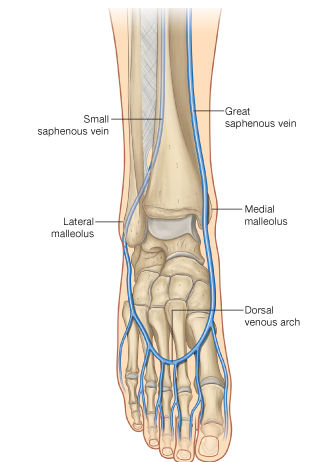
Formation of Dorsal Venous Arch
On the dorsum of the foot the dorsal digital veins communicates with planter digital veins and then join to form Dorsal Metatarsal veins, which unite across the proximal parts of the metatarsal bones to form Dorsal Venous Arch.
Formation of Marginal Veins
Proximal to dorsal venous arch is an irregular venous net-work which receives tributaries from the deep veins and is joined at the sides of the foot by a medial and a lateral marginal vein, formed mainly by the union of branches from the superficial parts of the sole of the foot.
Plantar Cutaneous Venous Net-Work
On the sole of the foot the superficial veins form a plantar cutaneous venous arch which extends across the roots of the toes and opens at the sides of the foot into the medial and lateral marginal veins. Proximal to this arch is a plantar cutaneous venous net-work, this net-work communicates with the cutaneous venous arch and with the deep veins, but is chiefly drained into the medial and lateral marginal veins.
Great Saphenous Vein
The great saphenous vein is the longest vein in the body
BEGINS in the medial marginal vein of the dorsum of the foot and
ENDS in the femoral vein about 3 cm. below the inguinal ligament.
COURSE: It ascends in front of the tibial malleolus and along the medial side of the leg in relation with the saphenous nerve. It runs upward behind the medial condyles of the tibia and femur and along the medial side of the thigh and, passing through the fossa ovalis, ends in the femoral vein.
The valves in the great saphenous vein vary from ten to twenty in number; they are more numerous in the leg than in the thigh.
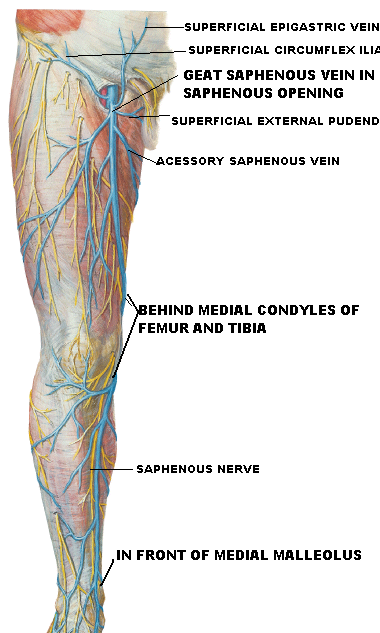
Tributaries of Great Saphenous Vein
At the ankle
it receives branches from the sole of the foot through the medial marginal vein;
In The Leg
it anastomoses freely with the small saphenous vein, communicates with the anterior and posterior tibial veins and receives many cutaneous veins
In The Thigh
it communicates with the femoral vein and receives numerous tributaries; those from the medial and posterior parts of the thigh frequently unite to form a large accessory saphenous vein which joins the main vein at a variable level.
Near the Saphenous Opening
it is joined by the superficial epigastric, superficial iliac circumflex, and superficial external pudendal veins.
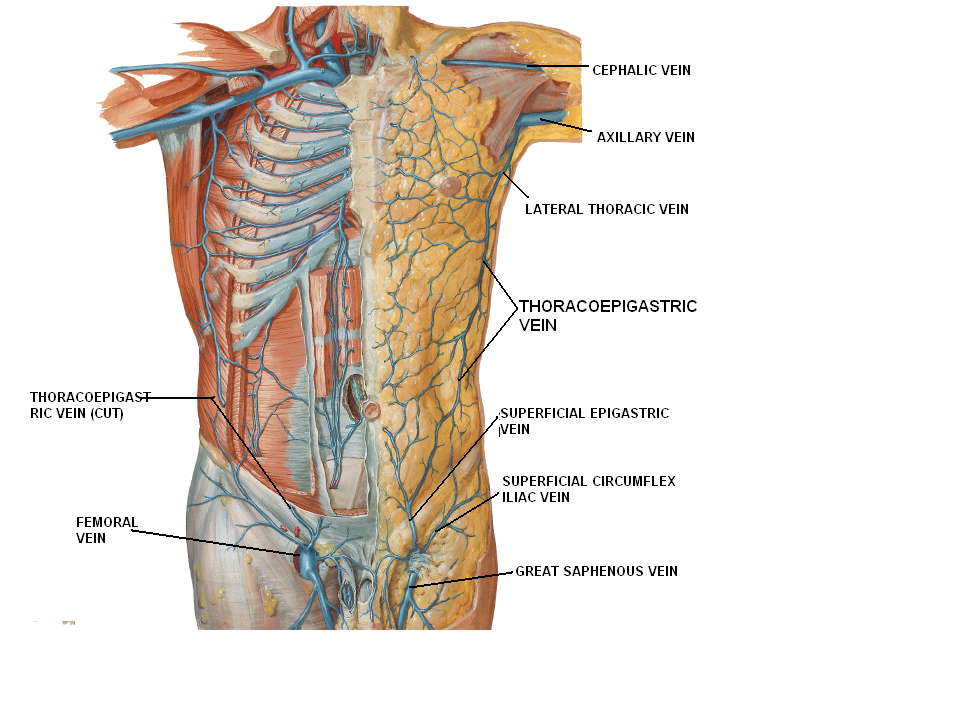
Thoracoepigastric vein
runs along the lateral aspect of the trunk between the superficial epigastric vein below and the lateral thoracic vein above and establishes an important communication between the femoral and axillary veins.
S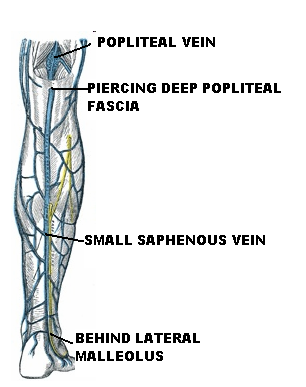 mall
Saphenous Vein
mall
Saphenous Vein
The small saphenous vein begins behind the lateral malleolus as a continuation of the lateral marginal vein; it first ascends along the lateral margin of the tendocalcaneus, and then crosses it to reach the middle of the back of the leg. Running directly upward, it perforates the deep fascia in the lower part of the popliteal fossa, and ends in the popliteal vein, between the heads of the Gastrocnemius The small saphenous vein possesses from nine to twelve valves, one of which is always found near its termination in the popliteal vein.
Tributaries
It communicates with the deep veins on the dorsum of the foot, and receives numerous large tributaries from the back of the leg. Before it pierces the deep fascia, it gives off a branch which runs upward and forward to join the great saphenous vein
Superficial Lymphatic Vessels & Nodes of lower limb
S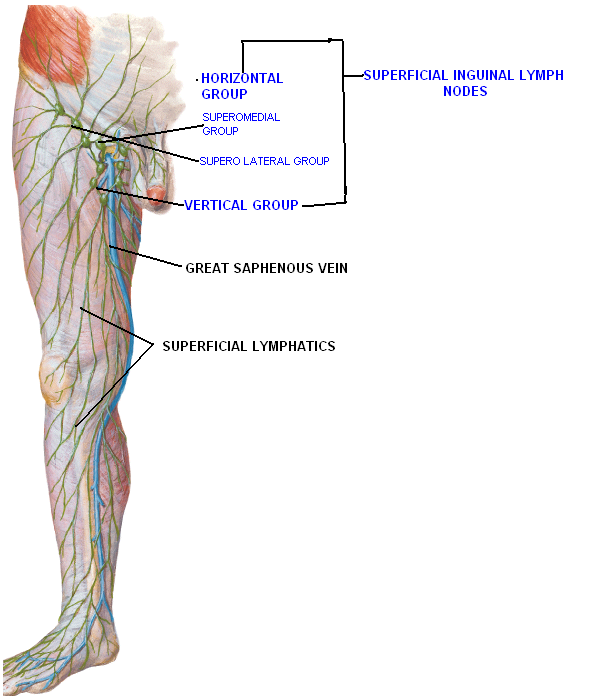 uperficial
inguinal lymph nodes
uperficial
inguinal lymph nodes
Transverse Group
vertical group
Transverse group of superfificial inguinal lymph node
Lies just distal to the inguinal ligament
Divided into medial and lateral parts
Drainage :
Medial part receive lymph vessels from :
anterior abdominal wall below umbilicus
perineal region
external genital organs
lateral part receive lymph vessels from:
back below the level of iliac crests including gluteal region
Vertical Group of Inguinal Lymph Nodes
Lies vertical along the terminal great saphenous vein
Receives all superficial lymph vessels of lower limb, except for those from the posterolateral part of calf
Efferent vessels drain into the deep inguinal lymph nodes or external iliac lymph nodes
FICHA TÉCNICA FUENTE SUPERFICIAL DEL RÍO BERMEJO OBRA DE
HIDROLOGÍA SUPERFICIAL Y SUBTERRÁNEA 20152016 BOLETÍN DE PROBLEMAS PROBLEMA
MEMORIA DESCRIPTIVA DRENAJE SUPERFICIAL EN PLANTA CONCENTRADORA SECTOR ESPESADORES
Tags: learning objectives, superficial, vessels, lymphatics, objectives, lower, learning
- 國立臺北藝術大學 二代健保補充保險費退費申請書 保險對象 身份證字號 (居留證號) 姓名 出生日期 年 月
- MINISTÉRIO DA DEFESA | PROTOCOLO DIVJUR N º
- PROTECTION AND PERMANENCY TRANSMITTAL LETTER PPTL 0312 TO SERVICE
- WWWMONOGRAFIASCOM ALTERNATIVAS PARA LA COMUNICACIÓN DE UN AUTISTA GABRIELA
- MARTES 4 DE MAYO DE 2021 DIARIO OFICIAL 4
- NOTA DE PRENSA ¿QUIÉN SE SIENTA BIEN EN LA
- HEC FAKULTET ZA INTERNACIONALNI MENADŽMENT U TURIZMU I HOTELIJERSTVU
- GÜÇ SISTEMLERINDE SERBESTLEŞTIRMEDEN SONRA OTOMATIK ÜRETIM KONTROLUNUN OPTIMIZASYONU IÇIN
- LESSON ELEMENT POPULATIONS SAMPLES AND SAMPLING METHODS
- LA EDUCACIÓN EN VALORES A TRAVÉS DEL FLAMENCO LA
- 5 VAN HUISHOUDEN (OIKONOMIA) NAAR ECONOMIE ARISTOTELES OVER HET
- G EOMETRÍA– SEGUNDO GRADO DE PRIMARIA PERÍMETRO ES
- HOOFDSTUK 6 BELGISCHE VENNOOTSCHAPSVORMEN IN DE NEGENTIENDE EN DE
- UMOWA NR SUKTAM……17W ZAWARTA W DNIU …………
- ALEGACIONES AL GRUPO ASIGNADO GRADO EN CC ACTIVIDAD FÍSICA
- TRANSFUSION SUPPORT FOR CLINICAL SERVICES INTRODUCTION THIS DOCUMENT PROVIDES
- PHOTO HERE BEST SCHOOL SUBJECTS MATHS PHYSICS
- ÁREA MATEMÁTICA AÑO 7º TEMA CUADRILÁTEROS PROBLEMA 1 A
- HERRAMIENTAS DE OFICINA EXISTEN MUCHAS ALTERNATIVAS EN EL CAMPO
- SKUPINA A 1 BIOKEMIČNO PRESEJAVANJENA PODLAGI KATEREGA PRERAČUNAMO TVEGANJE
- PEMETAAN KONFORM DISTRIBUSI MEDAN ELEKTROMAGNETIK DENGAN METODE BEDA HINGGA
- NEDP – MARYLAND (09012016) A CLICK ON MAP FOR
- SPIS TREŚCI POLITECHNIKA CZĘSTOCHOWSKA WYDZIAŁ INŻYNIERII MECHANICZNEJ I INFORMATYKI
- 114 BELGISCHE SENAAT DE SENAAT TIJDENS DE ZITTING 20052006
- 18 CIRCULAR N°38 DEL 08 DE JULIO DEL 2008
- INSTRUCTION BP 6000(A) CONCEPTS AND ROLES THE BOARD OF
- MT SAN ANTONIO COLLEGE DISCIPLINEDEPARTMENTLEARNING LAB (LAC)CONTACT MARGIE ARAMBULA
- KÉRELEM A KÖTELEZŐ ÓVODAI NEVELÉSBEN VALÓ RÉSZVÉTEL ALÓLI FELMENTÉSHEZ
- STATENS STANDARDAVTALER FOR ITANSKAFFELSER KJØPSAVTALEN STATENS STANDARDAVTALE OM KJØP
- VINÇOTTE NEDERLAND BV HOOFDKANTOOR TAKKEBIJSTERS 8 ▪ 4817 BL
ELS PRONOMS FEBLES 1 FORMA DELS PRONOMS FEBLES PRONOMS
 REVISION GUIDANCE H NURTON TOP TEN REVISION TIPS 1
REVISION GUIDANCE H NURTON TOP TEN REVISION TIPS 1 PRESS RELEASE CAZINOUL DIN CONSTANȚA ROMÂNIA ESTE PRINTRE CELE
PRESS RELEASE CAZINOUL DIN CONSTANȚA ROMÂNIA ESTE PRINTRE CELEINFORMACIJA KAUNO MIESTO IR RAJONO GYVENTOJAMS APIE AUGINTINIŲ SKIEPIJIMĄ
 TC CUMHURİYET ÜNİVERSİTESİ ECZACILIK FAKÜLTESİ KAMU HİZMET ENVANTERİ TABLOSU
TC CUMHURİYET ÜNİVERSİTESİ ECZACILIK FAKÜLTESİ KAMU HİZMET ENVANTERİ TABLOSUCOLECCIÓN EN TIERRA DE OZAIN (1RA PARTE)
PILARREKO MEDIATEKAN KLIMATIZAZIO LANAK IZANGO DIRA MAIATZAREN 9TIK 13RA
CHAPTER 10 MULTIPLE CHOICE QUESTIONS 1 WHICH APPROACH TO
OCENA RYZYKA ZAWODOWEGO STWARZANEGO W TRAKCIE REALIZACJI PRAC NA
FORMAT 2 RENCANA KERJA A RENCANA KERJA TAHAPAN PEMBANGUNAN
 “INFORMATIKA JE POTREBA A NE HIR” NEPOZNATI AUTOR 1
“INFORMATIKA JE POTREBA A NE HIR” NEPOZNATI AUTOR 1 GIRL MOVED TO TEARS BY OF MICE AND MEN
GIRL MOVED TO TEARS BY OF MICE AND MEN II REUNIÓN INTERAMERICANA DE LOS MINISTROS DE CULTURA Y
II REUNIÓN INTERAMERICANA DE LOS MINISTROS DE CULTURA Yfor 19991027 nr 1166 Instruks for Tilsyn og Kontroll
 STAMPIA OFICIAL DI AFL 4 FRANS NA MINISTER DI
STAMPIA OFICIAL DI AFL 4 FRANS NA MINISTER DI MEMORANDUM ELECTRONIC GOVERNMENT 3 ELECTRONIC GOVERNMENT ALS SCHLÜSSEL ZUR
MEMORANDUM ELECTRONIC GOVERNMENT 3 ELECTRONIC GOVERNMENT ALS SCHLÜSSEL ZUR JACKSONVILLE WATERWAYS COMMISSION BILL BISHOP CHAIR JACKSONVILLE WATERWAYS COMMISSION
JACKSONVILLE WATERWAYS COMMISSION BILL BISHOP CHAIR JACKSONVILLE WATERWAYS COMMISSION CLASE 09 PRODUCTOS ALGEBRAICOS Y FACTORIZACIÓN TANTO EN LA
CLASE 09 PRODUCTOS ALGEBRAICOS Y FACTORIZACIÓN TANTO EN LA CONVOCATORIA DE BECAS DE INVESTIGACIÓN APLICADA A MICROCREDITOS PARA
CONVOCATORIA DE BECAS DE INVESTIGACIÓN APLICADA A MICROCREDITOS PARA 6 8B140E INTERNATIONAL TELECOMMUNICATION UNION AMCP WGF7WP55
6 8B140E INTERNATIONAL TELECOMMUNICATION UNION AMCP WGF7WP55